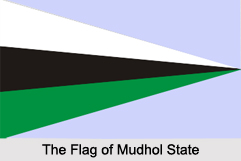 Mudhol State is today recognized as a princely state that existed in India during the rule of the British Empire. It was one of the former states of the Southern Maratha Country and is today a part of the Indian state of Karnataka. The city of Mudhol was the capital of this state and was located in the present-day Bagalkot District. 8th March, 1948 is known to be the accession date of this princely state. Mudhol was thus added to the Indian Union. The religion known to be followed in this state was Hinduism. Mudhol State is also known to be a Second Class state.
Mudhol State is today recognized as a princely state that existed in India during the rule of the British Empire. It was one of the former states of the Southern Maratha Country and is today a part of the Indian state of Karnataka. The city of Mudhol was the capital of this state and was located in the present-day Bagalkot District. 8th March, 1948 is known to be the accession date of this princely state. Mudhol was thus added to the Indian Union. The religion known to be followed in this state was Hinduism. Mudhol State is also known to be a Second Class state.
Geography of Mudhol State
Mudhol State was recorded to be spread over an area of about 508 square kilometers, in the year 1931. In the year 1892, the population of the state was recorded at 52,163. The census of 1901, recorded the population in the state area to be near about 63,001, with the population of the town itself at 8,359 in that year. In the year 1931, the population of the Mudhol State was recorded at 936,218. Density of human population was also recorded for the state as 1,842.9 /km2 (4,773.2 /sq mi). As per estimations, the recorded revenue of this state was about £20,000, in the year 1901.
History of Mudhol State
The Mudhol prior to becoming a state existed as an estate (also known as jagir). It was established in the year, 1465. Bhonsle or Ghorpade lineage is known to be the dynasty which ruled this princely state.
The rulers claim descent from the Ranas of Chittor. In the year 1670, Mudhol estate was finally converted into a state. It became a British protectorate in the year 1819. It is known to be one of the 9-gun salute states of British India, under the summit of Niranjan.
Rajas of Mudhol State
Mudhol State is known to be ruled by twenty three kings. Rana bhairavji was the king who granted the Jagir of Mudhol, which had 84 villages. With this ruler, the family came to use Bhosale or Bhonsle as a family name. The names of some of the other kings of Mudhol State are listed below-
•Maloji Raje Ghorpade (1662 - 1700)
•Sardar Akhayaji Raje Ghorpade (1700 - 1734)
•Pirajirao Raje Ghorpade (1734 - 1737)
•Malojirao III Raje Ghorpade (1737 - 1805)
•Narayanrao Raje Ghorpade (1805 - 1816)
•Govindrao Raje Ghorpade (1816 - 20 February 1818)
•Vyankatrao I Raje Ghorpade (20 February 1818 - December 1854)
•Balwantrao Raje Ghorpade (December 1854 - 27 March 1862)
•Vyankatrao II Raje Ghorpade (27 March 1862 - 19 June 1900)
•Malojirao IV Raje Ghorpade (19 June 1900 - 14 November 1939)
•Council of Regency(19 June 1900 - 1904)
•Bhairavsinhrao Raje Ghorpade (14 November 1937 - 15 August 1947)
•Parvatidevi Raje Sahib - Ghorpade (14 November 1937 - 10 July 1947)
HH Shrimant Raja Bhairavsinhrao Malojirao Ghorpade II is known to be the last king of Mudhol State. He was born on 15th of October, 1929 and succeeded to the throne on 9th of November, 1937. He is known to be the 23rd king of Mudhol. On 8th March 1948, he became the Mudhol king to sign the accession of this princely state to the dominion of India. He died in 1984 in a car accident. Since 1984, the throne of this state is vacant.
Flag of Mudhol State
The princely flag of Mudhol State is known as Bahuta. It is identified as a triangular tricolor flag with horizontal bands. These bands are coloured as white, black and green from the top. These bands diverge from a point on the flag.
The Mudhol Hound
The Mudhol hound is known to be resurrected by Shrimant Rajesaheb Malojirao Ghorpade (1884–1937) of Mudhol State. This became possible when he noticed local tribal people using these hounds for hunting. Selective breeding was the technique on which the revival of the royal Mudhol hound was dependent. The Maharaja of Mudhol State went to England in the early 1900s. He then presented King George V with a pair of hounds. The Mudhol hound breed then attained popularity.
Related Articles:
Modern History of India
British Empire in India
Princely States of India






































